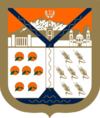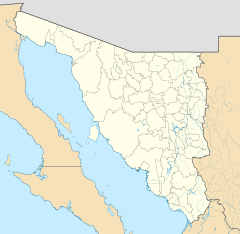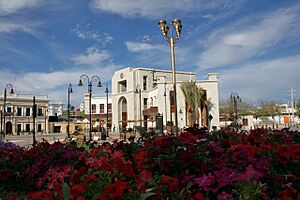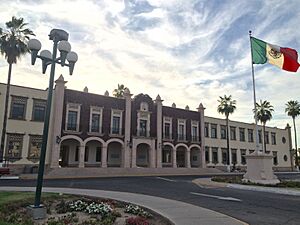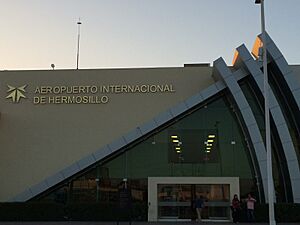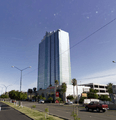Hermosillo facts for kids
Quick facts for kids
Hermosillo
Pitic
|
|||||
|---|---|---|---|---|---|
| Ciudad de Hermosillo City of Hermosillo |
|||||
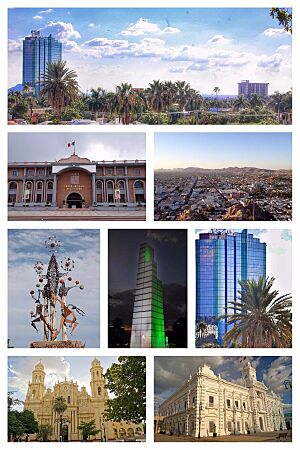
Panoramic view of Hermosillo, Judicial Power of the State of Sonora, View of the city, Sculpture, Fountain three boulevard, Hermosillo Tower, Catedral de la Asuncion in Hermosillo, Government Palace of Sonora
|
|||||
|
|||||
| Nickname(s):
"La ciudad del sol" ("The City of the Sun")
|
|||||
| Country | |||||
| State | |||||
| Municipality | Hermosillo | ||||
| Founded | May 18, 1700 | ||||
| Municipal Status | February 9, 1825 | ||||
| Founded by | Juan Bautista de Escalante | ||||
| Named for | José María González Hermosillo | ||||
| Area | |||||
| • City | 168.20 km2 (64.94 sq mi) | ||||
| Elevation
(of seat)
|
200 m (700 ft) | ||||
| Population | |||||
| • City | 855,563 | ||||
| • Density | 4,800/km2 (12,500/sq mi) | ||||
| • Urban | 899,817 | ||||
| • Metro | 944,000 | ||||
| Demonym(s) | Hermosillense | ||||
| GDP (PPP, constant 2015 values) | |||||
| • Year | 2023 | ||||
| • Total | $33.4 billion | ||||
| • Per capita | $36,700 | ||||
| Time zone | UTC−7 (Zona Pacífico) | ||||
| Postal code (of seat) |
83000
|
||||
| Area code(s) | 662 | ||||
| Website | /Official site: http://www.hermosillo.gob.mx | ||||
Hermosillo, once known as Pitic, is a vibrant city in the center of Sonora, a state in northwestern Mexico. It is the capital and largest city of Sonora. Hermosillo is also the main economic hub for the state and the surrounding region. In 2020, the city had a population of over 936,000 people. This makes it one of the largest cities in Mexico. Its population has grown a lot because of new industries, especially car manufacturing.
Hermosillo is known for its great quality of life. It has been ranked among the top cities in Mexico for this reason. The city is also very competitive, thanks to its diverse economy, good location, and access to education. It is one of the richest cities in Mexico when looking at its economic output per person. Hermosillo has a hot desert climate, with summer temperatures sometimes reaching very high levels. This has earned it the nickname "The City of the Sun."
Contents
- Discovering Hermosillo: The City of the Sun
- Images for kids
- See also
Discovering Hermosillo: The City of the Sun
A Glimpse into Hermosillo's History
Ancient Roots and Early Settlements
People have lived in the Hermosillo area for about 3,000 years. Evidence shows that farming started here 2,500 years ago. Before the Spanish arrived, indigenous groups like the Seri, Tepoca, and Pima lived in this region.
Spanish explorers first came in the mid-1500s, looking for gold. Jesuit missionaries followed in the early 1600s. In 1700, three small Spanish villages were founded near what is now Hermosillo. These were Nuestra Señora del Pópulo, Nuestra Señora de Los Angeles, and la Santísima Trinidad del Pitic. A fort, the Presidio of Pitic, was built around 1726 to protect the Spanish settlers.
From Pitic to Hermosillo
During the Mexican War of Independence, the town of Pitic remained loyal to Spain. After Mexico gained independence in 1825, Pitic became the head of its own department. In 1828, the town was renamed Hermosillo. This honored José María González de Hermosillo, a leader who fought for Mexico's independence.
In 1879, Hermosillo became the capital of the state of Sonora. A railroad connecting the city to Guaymas and Nogales was completed in 1881. This helped the city's economy grow by bringing in equipment for mining and farming. Hermosillo has been an important economic center for northwest Mexico ever since.
During the Mexican Revolution (starting in 1910), Hermosillo played a key role. Venustiano Carranza, a governor who later became president, found refuge here. He started the Constitutionalist Movement in Hermosillo. Because of this, the city is known as the "revolutionary capital of the country."
Growth and Modern Challenges
In the early 1900s, many Chinese immigrants settled in Hermosillo. They started businesses, especially in shoe and clothing manufacturing. These businesses helped the city's economy.
In the 1980s, the Ford Motor Company built a car manufacturing plant in Hermosillo. This factory greatly boosted the city's and state's economy. Many other businesses that supply parts to the car industry also grew around it.
In 2009, a sad event occurred in Hermosillo. A fire at a child care center caused the loss of many young lives. This tragedy led to important changes in laws across Mexico. These new rules help make sure child care centers are safer for all children. To remember this event, June 5th is a day of national mourning in Mexico.
Hermosillo's Unique Environment
Climate: Hot and Sunny!
Hermosillo has a hot desert climate. Temperatures can be very high in summer, sometimes reaching over 48 degrees Celsius (118 degrees Fahrenheit). Winters are mild, but temperatures can drop to freezing in December and January. Most of the rain falls between July and September.
Plants and Animals of the Sonoran Desert
The area around Hermosillo is part of the Sonoran Desert. You can find many mesquite trees here. Other plants include blue agave, desert ironwood, and palo verde.
The desert is home to various animals. You might see desert tortoises, different types of rattlesnakes, and kingsnakes. Larger animals include mule deer, collared peccary, raccoon, and coyote. Sometimes, bobcats and even pumas are spotted. Recently, a jaguar was seen in the Hermosillo area, which was very exciting! The critically endangered Sonoran pronghorn antelope also lives in this region.
Life and Economy in Hermosillo
People and Progress
Most of the people in the Hermosillo municipality live in the city itself. The city's population has grown quickly due to its strong industrial development. This growth is especially thanks to the car manufacturing industry and its suppliers.
How Hermosillo Works: Industry and Trade
Industry and manufacturing are the most active parts of Hermosillo's economy. The Ford Motor Company plant, built in the 1980s, was a major start for this. Today, many factories produce cars, electronics, computers, and other goods. These industries create thousands of jobs for the city's residents.
Farming is also important in the areas outside the city. Farmers grow crops like wheat, grapes, and chickpeas. Raising livestock, especially beef cattle, has a long history here. Fishing along the coast, with shrimp as a main catch, also contributes to the economy.
Commerce, or trade, employs more than half of the people. You can find many local shops and large chain stores. Tourism is popular in coastal areas like Bahía Kino, known for its beaches and cultural sites.
Learning and Staying Healthy
Schools and Universities
Hermosillo values education. Almost all young people aged 15 to 24 can read and write. School attendance is high for children and teenagers.
The city has many places for higher education. The Universidad de Sonora is a large university with thousands of students. Other important institutions include the Technological Institute of Hermosillo and the Monterrey Institute of Technology and Higher Education Sonora Norte campus.
Hospitals and Healthcare
Hermosillo has important hospitals that serve the entire state of Sonora. These include the General Hospital of the State of Sonora, the Children's Hospital, and the Women's Integral Hospital. There are also many other medical clinics and hospitals, both public and private. Most people in Hermosillo have access to some form of health insurance.
Fun and Culture in Hermosillo
Sports for Everyone
Hermosillo loves sports! Baseball is very popular. The city's professional team, the Naranjeros de Hermosillo, has won many championships. They play at the Estadio Sonora. Hermosillo has also hosted international baseball tournaments for young players.
Basketball is also a big deal with the Rayos de Hermosillo team. They have won several league titles. For football (soccer) fans, the Cimarrones de Sonora FC plays in the national league.
Exploring City Landmarks
The heart of Hermosillo is Plaza Zaragoza. This beautiful square has a unique Moorish-style gazebo brought from Italy. It's a great place to relax and see statues of important historical figures.
The plaza is surrounded by impressive buildings. The Palacio de Gobierno (Government Palace) is a grand building with a white facade and murals inside that show Sonora's history. Next to the plaza is the Catedral de la Asunción. This large church has a mix of architectural styles and was completed in the early 1900s.
The Sonora Museum of Art (MUSAS) is a modern space dedicated to art and culture. It features various exhibitions from different artists.
Nature Adventures and Cultural Experiences
The Cerro de la Campana mountain is a famous symbol of Hermosillo. You can go up to a lookout point called El Caracol for amazing views of the city. People say the mountain got its name because its rocks make a bell-like sound when they hit each other.
Just outside the city, the Centro Ecológico de Sonora (Ecological Center of Sonora) is a fantastic place to visit. It has over 300 types of plants and 200 species of animals. You can see animals from Sonora's mountains, grasslands, deserts, and sea, all in natural-like habitats. Some of these animals are endangered, like the bighorn sheep.
The Yaqui people in Hermosillo celebrate Holy Week with unique traditions. They mix Catholic and indigenous practices, performing traditional dances like the Deer Dance. This dance is very important to the Yaqui, as the deer symbolizes good.
Other fun events include the Fiesta de la Vendimia (Grape Harvest Festival) in July. The Feria Exposición Ganadera e Industrial (Livestock and Industry Exposition and Fair), known as Expogán, happens in April and May. It's a big family event with games, music, and shows by famous artists.
Kino Bay and Tiburón Island
Kino Bay is a beautiful beach area named after Eusebio Francisco Kino, an early missionary. It's a popular spot for relaxation. Nearby, the Ethnic Museum of the Seris teaches visitors about the "Comcaac" people, also known as the Seri. This museum shares their history, culture, and way of life.
Tiburón Island is the largest island in Mexico and an important ecological reserve. It was once home to the Seri people and holds great religious meaning for them. The island is full of diverse plants and animals, including many birds, reptiles, and fish.
Getting Around the City
Hermosillo has an international airport, General Ignacio Pesqueira García International Airport. It offers flights to other Mexican cities and to Phoenix in the United States. The city also has a public bus system with many routes covering most of Hermosillo. Major highways connect Hermosillo to other cities like Nogales and Culiacán.
Hermosillo's Global Connections
Hermosillo has "twin city" relationships with several cities around the world. These connections help promote cultural exchange and friendship. Some of its twin cities include Phoenix, Arizona and Irvine, California in the United States, and Torreón, Coahuila in Mexico.
Famous Faces from Hermosillo
Many talented people come from Hermosillo.
- Juan Ciscomani (born 1982) – A U.S. representative from Arizona.
- Cesar Rosas – A Mexican-American singer and guitarist from the band Los Lobos.
- Isaac Paredes – A professional baseball player for the Houston Astros.
Images for kids
-
Anastasio Cuca, Yaqui leader, 1887
See also
 In Spanish: Hermosillo para niños
In Spanish: Hermosillo para niños



